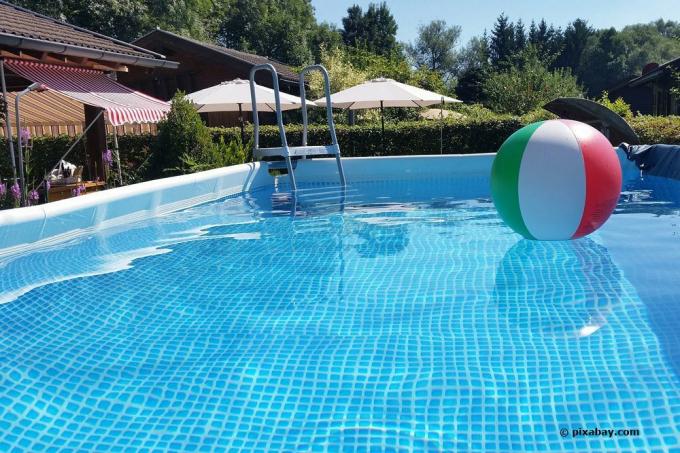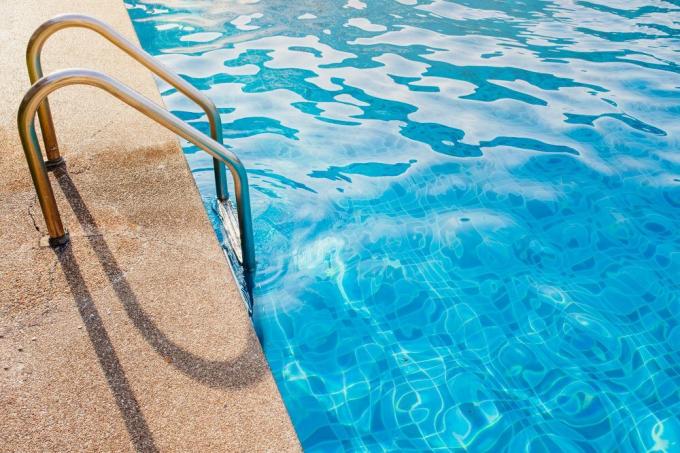
table of contents
- Well water in the pool
- Common problems
- Check well water
- Filter system
- Fill the pool with well water
- instructions
Having a pool in the garden can be a huge drain in terms of running costs. For this reason, many pool owners consider whether they should use the much cheaper well water, if this is available. However, since this is water that can be mixed with microorganisms, pollutants and heavy metals, certain points must be observed when using it. However, if you use the appropriate instructions, you can do this without any problems.
Well water in the pool
Regardless of whether you have already filled or refilled your pool with water from the well, if certain points are not observed, a multitude of problems can quickly arise. The reason for this are the numerous impurities that occur in well water and have a significant effect on its quality. Compared to tap water, water from the well is not treated in the same way and therefore, depending on the region, it can contain numerous substances:
- iron
- manganese
- nitrate
- ammonium
- Calcium
- magnesium
- acid
- Heavy metals (rare)
- Pesticides (rare)
- Germs (rare)
- Bacteria (rare)
Contamination by heavy metals, germs, bacteria or pesticides is not so common, but it is a bigger problem in rural areas, especially if your well is in close proximity to a farm or livestock is located. It is the same with factories. However, they can fill your pool with the water as the detergents and chlorine work effectively against them.
Common problems
Problems can quickly arise with well water due to the high concentration of metals, which ruin the bathing fun in your own garden. You may face the following problems:
1. Discoloration
A typical problem when filling the well with water is possible discoloration, which can vary in strength. This is particularly uncomfortable in small pools, as in these the discoloration is noticeable much faster and does not really invite you to swim.
2. rust
Rust deposits caused by the metals in the well water are less common. As these oxidize, equipment or other metal objects can begin to rust, which will require repairs so that you can continue to use the pool undisturbed.
3. Limescale deposits
In rare cases, there may be increased calcium deposits if your groundwater is very calcareous. When used in the swimming pool, this is mainly transferred to the walls and the floor and settles there, which makes maintenance extremely difficult.
As such, there is nothing wrong with using water from the well when you want to fill your pool. However, you have to reckon with increased effort, which will also affect your running costs. The reason for this is of course the special means that you need to treat the pool water so that it does not discolor or lead to rust and limescale deposits. Because of this, you may even end up using the well water in the pool Save very little and classic tap water turns out to be much more effective would.
Note: Water from the well can even be a health hazard when swimming in the pool if chlorine has not been used beforehand. But this is only the case with children, the elderly, or people who are already weakened or sick and who cannot withstand even low levels of contamination.
Check well water
One of the most important points when filling the pool with well water is checking it. This is important because this is the only way to know whether the use of the well water is worthwhile at all. You will need the following items to check:
- Plastic bucket (white)
- 10 grams of chlorine granules
- Well water
- floor
Nothing more is needed for the check, as this is a color test that gives an obvious result. Make sure that the bucket is not only white, but completely dispenses with a pattern. This makes it a lot easier to see the resulting hue, which will help you check it out. One of them is ideal as a stick bamboo, since in most cases less dirt adheres to them, which could negatively influence the test. Alternatively, you can protect your hand with a disposable glove and use it to stir. Once you have all the materials together, you can start the test:
- Thoroughly clean the bucket
- dry
- Fill the bucket with water from a well
- Add chlorine concentrate
- stir
- use the stick or hand for this
- Waiting time: 60 to 120 minutes
- Check water
If there are metals in the filling water, it will have taken on a different color after the waiting time. The discoloration shows exactly which metal is in which concentration and whether it is possible to fill your pool with it. Discoloration due to metal ions is caused by oxidations that are triggered by the chlorine and then dissolved in the water. Different metals provide different color tones and show exactly how high their intensity is. The following colors are possible:
- clear: no metal ions
- green: low iron content
- brown: high iron content
- black: manganese
Filter system
Iron is much more common in water, but discoloration from manganese cannot be ruled out. Since the coloring is very clear and you are using a white bucket, this way you can see nuances between the shades much better. Here it is important to know that it is only advisable to fill a pool with well water if it has a sand filter system. The reason? Many of the special agents that work against the metal ions in water are unsuitable for use with filter cartridges. These would only clog them because they work in a similar way to flocculants. However, these are not agents that are specially designed for filter cartridges. If you still use the special agents, the following problems can arise:
- Water pollutes more
- Water pollutes faster
- Cartridges wear out faster
- Limescale deposits
Since filter systems with cartridges are also often used for smaller pools, the cost savings through the use of well water are very low. A large pool with a sand filter system, on the other hand, is ideal if you have the right products apply and use the instructions below to use the well water for the pool do. It is best to use tap water for small pools. This saves you work and the purchase of special resources, which would also put a strain on your wallet.

Note: If you have not yet used any chlorine granules, you must purchase them beforehand on the Internet, from specialist retailers or in hardware stores. On average, between 1.5 and two euros is required for 100 grams of chlorine granulate, which means that the cost of the test, apart from the plastic bucket, is around 15 to 20 cents.
Fill the pool with well water
Filling your pool with water from the well is more time-consuming than with classic tap water. It is important to use suitable treatment agents that counteract the metals and other contaminants in the water. For this reason, you need a so-called metal neutralizer from brands such as PoolsBest, HP or Steinbach. This agent is essential because it prevents the binding of metals in the water and thus discoloration and other undesirable problems. They are available for around seven to ten euros per liter. You also need:
- chlorine
- pH meter
With chlorine, you have the choice between granules and tablets, which are particularly easy to use. Now you can start filling your pool with well water or topping up the existing content. The instructions are suitable for both variants.
Note: If you are still in the planning phase of your pool and the Also build a well you must not forget that you are required to report. Since a well is set in the ground and opens up the groundwater, this must be reported so that the Construction and use do not contaminate the groundwater in any form or otherwise negatively influence.
instructions
1. Start by making a Shock chlorination perform. This accelerates the oxidation of the metals in the water much faster and in this way facilitates the use of the neutralizer. Iron and manganese in particular are effectively filtered and your water in the pool remains clear over the long term.
2. If you completely refill the swimming pool, you must clean it thoroughly beforehand. Be extremely meticulous in order to positively influence the effect of the remedies. Even if you only fill your pool with well water, cleaning measures before shock chlorination are worthwhile.
3. Now measure the pH of the water. The pH value helps to carry out the shock chlorination correctly, as it has to be around 7.2. The water should also not be too warm, because chlorination only works at a temperature of 15 ° C, which you must pay attention to.
4. Now add enough chlorine granulate or tablets that there are five milligrams of chlorine for every liter of filling water. This amount is completely sufficient to cause the metals to oxidize. For this reason, keep measuring the Chlorine contentin order to be able to adapt it perfectly. Then let your filter system run for a period of about 48 hours. This is especially recommended for the first chlorination. However, if you only fill your swimming pool with tap water, the value should be around the usual one milligram per liter.
5. Now apply a flocculant and also add the special agent to achieve the desired effect. When using neutralization, use the manufacturer's instructions as a guide, as the agents have different levels of effectiveness.
6. If the water from your well is particularly hard, you can use a hardness stabilizer. These even filter small amounts of metals.
It is important to repeat the process each time you top up, as the contaminants will get back into the pool via the well water.





